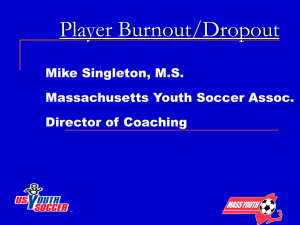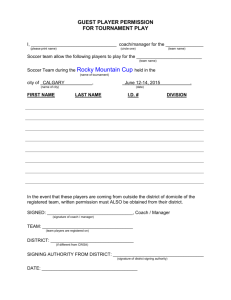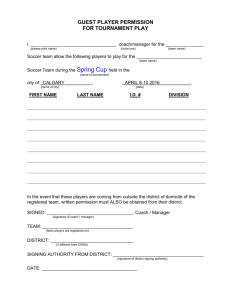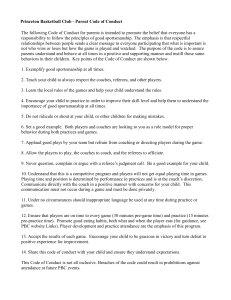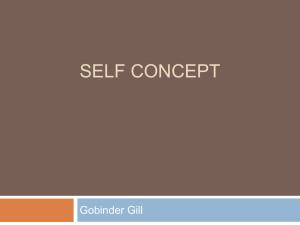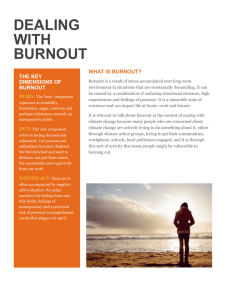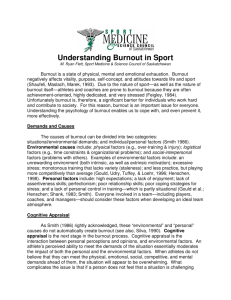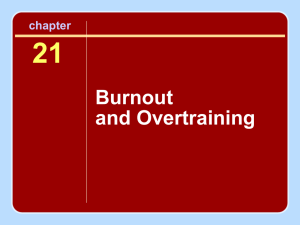Player Burnout and Drop Out: Causes and Cures
advertisement
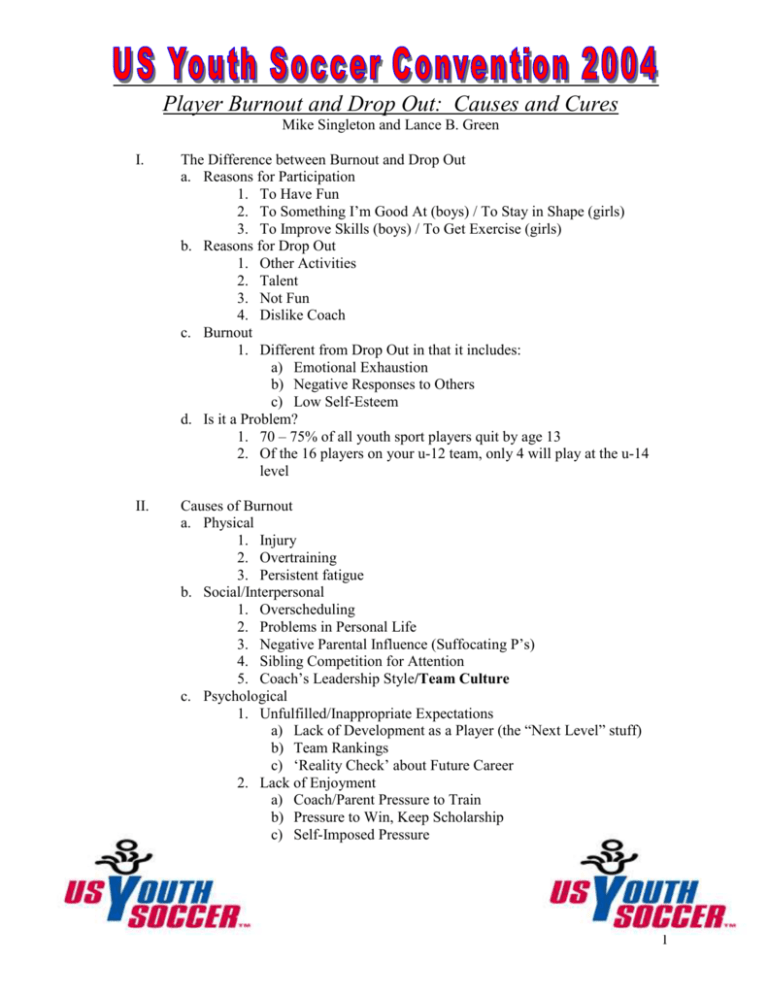
Player Burnout and Drop Out: Causes and Cures Mike Singleton and Lance B. Green I. The Difference between Burnout and Drop Out a. Reasons for Participation 1. To Have Fun 2. To Something I’m Good At (boys) / To Stay in Shape (girls) 3. To Improve Skills (boys) / To Get Exercise (girls) b. Reasons for Drop Out 1. Other Activities 2. Talent 3. Not Fun 4. Dislike Coach c. Burnout 1. Different from Drop Out in that it includes: a) Emotional Exhaustion b) Negative Responses to Others c) Low Self-Esteem d. Is it a Problem? 1. 70 – 75% of all youth sport players quit by age 13 2. Of the 16 players on your u-12 team, only 4 will play at the u-14 level II. Causes of Burnout a. Physical 1. Injury 2. Overtraining 3. Persistent fatigue b. Social/Interpersonal 1. Overscheduling 2. Problems in Personal Life 3. Negative Parental Influence (Suffocating P’s) 4. Sibling Competition for Attention 5. Coach’s Leadership Style/Team Culture c. Psychological 1. Unfulfilled/Inappropriate Expectations a) Lack of Development as a Player (the “Next Level” stuff) b) Team Rankings c) ‘Reality Check’ about Future Career 2. Lack of Enjoyment a) Coach/Parent Pressure to Train b) Pressure to Win, Keep Scholarship c) Self-Imposed Pressure 1 III. Contributing Factors to Burnout a. Parent-Athlete Relationship 1. Living vicariously through one’s child 2. A lack of the “Emotional Moat” 3. Parents comparing own child to others 4. Sideline Yelling/Coaching 5. Perspectives of Some Parents a) “I’m making sure my son doesn’t make the same mistakes I made.” b) “She’s our financial ticket.” c) “It’s his choice to play. He wants to do it.” d) “From the moment she came out of the womb, she was going to be a soccer player.” b. Coaching Styles 1. Playing favorites 2. Stressing outcomes 3. No playing time 4. Substitute after a mistake 5. Not talking to the team after a loss 6. Relating performance to the worth of the child 7. Making ‘friendship’ conditional on performance c. Team Culture 1. Team Climate a. Trust . . . Distrust b. Autonomy . . . Shame/Doubt c. Pro-Active . . . Reactive d. Identity . . . Confusion e. Relationships . . . Isolation f. Selflessness . . . Selfishness g. Ego-Strength . . . Ego-Tripping 2. Self-Mastery v Outcome Orientation IV. Psychological Considerations a. Children’s Interpretations of “What People Think About Me” 1. Others liking me is conditional upon my being a star 2. No matter how hard I try, it is never good enough 3. If I don’t play, I won’t get yelled at b. Ego/Outcome v Task/Self-Mastery Orientations 2 c. External Control of Decision-making 1. The effects of high performance sport on identity and control issues in young athletes 2. Coaches and Parents make most (if not all) decisions and exert control over scheduling, lifestyle 3. Athletes are left powerless to control events or make decisions about activities or friends outside of sport 4. Intrinsic Motivation (Love of the Game) is replaced by Learned Helplessness d. Unidimensional Identity 1. Who are you? . . . . “I’m an athlete.” 2. What do you do outside of sports? . . . . . “Nothing.” 3. What do you want to be when you grow up? . . . . “An athlete.” V. Symptoms of Overtraining/Staleness/Burnout a. Depression b. Apathy c. Sleep Disturbance d. Persistent Illness e. Injury Prone f. Defense Mechanisms g. Alienation h. Substance Abuse i. Sense of Failure j. Low Levels of Trust k. Low Self-Esteem l. Physical/Mental Exhaustion VI. Cures a. Coach’s Philosophy 1. cup as half empty or half full 2. spin doctor: the good news/bad news game 3. learned optimism: a ‘fix-it’ mentality 4. process and product thinking 5. overcome obstacles v defeating people b. Setting Short-term and Fun Goals 1. Product, Process and Performance Goals 2. Allow Team to Set Goals 3. Adapted Games 3 c. Communication 1. Listen 2. Sense of Humor 3. 975 Ways to Say “Good Job” 4. “Circle of Influence” (possibly include sport psychologist) 5. “Connect” with Two Players per Session 6. “Speak With” v “Talk At” d. Relaxation Breaks 1. Training Sessions of Shorter Duration, Lower Intensity 2. Time Off 3. Progressive Relaxation 4. Breathing Exercises, e.g., Up and Down the Ladder 5. Focused Stretching/Imagery during Warm Down e. Self-Regulation Skills 1. Productive Self-Talk: Learned Optimism 2. Emotional Control: Channeling Emotions into Game 3. Thought Stoppage 4. Relaxation Away from the Field, e.g., hobbies 5. Player’s Attributions (assuming responsibility for own play) 6. Coach’s Attributions (Share the Blame, Deflect the Glory) f. Consistency in Dealing with Wins, Losses 1. Bring Closure to Each Session, Each Game 2. The Four Questions a) How Do You Feel? b) What Did You Do Well? c) What Did You Not Do Well? d) What Is Your Plan For Tomorrow? 3. Unconditional Positive Regard 4. Focus on Emotions of Players, Not Your Own 5. “Connect” with Selected Players Post Game 6. Be A Class Act g. Create a Positive Culture 1. Identify Individual Improvement 2. Allow Players to Have a Say in Practices 3. Allow Laughing and Smiling 4. Activities, not Drills (Find Their Favorites) 5. Encourage Risk Taking and Creativity 6. Allow Self-Expression 7. Allow for Mistakes 8. Read Your Players’ Emotional Styles (Gender Differences, ‘Criticism Tolerance’) 9. Allow Them to Enjoy Success 10. Have Fun Yourself . . . It’s Contagious!! 4 h. Parent Education 1. Ask Them Why Their Child Plays 2. Observe the Interaction Between Parent and Child 3. Share Your Team and Individual Goals with Parents 4. Let Parents Know of Your Concerns 5. Inform Parents of Your Expectations of Them at Games/Practices 6. Beware of Vicarious Association/Develop the “Emotional Moat” 7. Beware of “The Ride Home”: The Post Game Analysis 8. Communicate with Parents Regarding Your Approach With Their Child 9. Involve Parents in selective team activities VII. What To Do If We’re Too Late a. Some Kids Will Remain in the Sport Regardless of Experiencing Burnout 1. Empathize 2. Suggest That They Take Selected Days Off 3. Do Whatever You Can To Help the Player Develop Coping Skills (refer to self-regulation) b. For Those Who Are Wise and Take the Necessary Time Off . . . 1. Consider Recommending a Counselor 2. Listen to Player’s Problems -- Empathize 3. Maintain Communication With Them 4. Discuss Situation With Parents Presented by: Lance B. Green, Ed.D. Dept. of Exercise & Sport Sciences Tulane University lbgreen@tulane.edu Michael Singleton, M.S. Massachusetts Youth Soccer Assoc. Director of Coaching msingleton@mayouthsoccer.org 5
